Oxfordshire
Explore hidden histories, historic photos, and things you never knew about Oxfordshire from the collections and archives of Historic England.
Discover your local listed buildings and places
Introducing some of Oxfordshire's most historic sites, included in the National Heritage List for England. Some of these captions have been summarised by AI. Click through for the official List entry. Skip this section and go to place by numbers
Heythrop Park
Enstone
Heythrop Park is an early 18th-century country house known for its formal gardens, lakes, avenue, and historical ties to notable figures like Charles Talbot, Duke of Shrewsbury.
Imperial Hotel and associated buildings
Henley-on-Thames
Hotel with parade of shops and domestic accommodation, c.1897 by William Theobalds. Read the official list entry to find out more.
The New House with surrounding pool and garden wall to th…
Shipton-under-Wychwood
A private house built in 1964 by Stout and Litchfield for Milton Grundy. Read the official list entry to find out more.
Friar Park
Henley-on-Thames
Friar Park, built in the late 19th century, features elaborate gardens designed by Frank Crisp, including a large rock garden and various themed sections, located in Henley-on-Thames.
Sarsden House
Churchill
Sarsden House is a notable country house redesigned in the 17th century, surrounded by a landscape crafted by Humphry Repton in 1795.
Bodleian Library and Schools Quadrangle Including the Div…
Oxford
The Bodleian Library and Schools Quadrangle, including the Divinity School and Convocation House, is a central and historically important group of buildings in Oxford, dating from 1424-1924.
Minchery Farmhouse
Littlemore
Minchery Farmhouse is a 15th-century structure, reconstructed around 1600, featuring significant architectural elements like stone-mullioned windows and a 17th-century staircase with Tudor...
Shipton Court
Shipton-under-Wychwood
Shipton Court, built in 1603, features gardens redesigned in the early 20th century by architects Perkins and Bulmer, showcasing fountains, ponds, and terraces amidst historical structures.
Sir Thomas White Building, St John's College
Oxford
Student accommodation and common rooms, designed 1967-70 by Philip Dowson of Arup Associates, built 1972-5. Read the official list entry to find out more.
Headington Hill Hall and attached forecourt wall
Oxford
Headington Hill Hall, built by John Thomas for brewer James Morrell in the 1850s, features a varied Italianate style with significant interior remodeling by architect William Wilkinson.
Eynsham Hall
Eynsham
Eynsham Hall, an Elizabethan-style country house rebuilt in the early 1900s, features extensive parkland, ornamental gardens, and historical ties to the Langford and Macclesfield families.
Chantry House
Henley-on-Thames
Chantry House is a circa 1400 timber-framed building featuring a mix of brick and plaster infilling, Tudor doorway, and distinctive early leaded glazing.
Magdalen College
Oxford
Magdalen College was founded by Bishop Waynflete in 1458. Its historic gardens and buildings include the Grove and Meadow, with contributions from Humphry Repton and William Townesend.
Blenheim Palace
Blenheim
Blenheim Palace, a Baroque country house, was built from 1706-29 for the Duke and Duchess of Marlborough, with carvings by Grinling Gibbons and interiors featuring works by Laguerre and...
Fairmile Hospital
Cholsey
Established in the late 19th century as a lunatic asylum, Fairmile Hospital was designed by C H Howell and features grounds planned by Robert Marnock. Today, it remains in institutional use.
Shirburn Castle
Pyrton
Shirburn Castle, originating from 1377, features significant gardens and pleasure grounds dating from the 18th and 19th centuries around a remodeled late 14th-century castle.
Cornbury Park
Charlbury
Cornbury Park, a 16th and 17th-century country house, was frequently visited by English royalty and was involved in significant historical events.
Manor House
Gosford and Water Eaton
The Manor House in Water Eaton, built circa 1586 for William Frere, features a rich array of architectural elements from the late 17th and 19th centuries.
Hilda Besse Building Including Stepped Plinth and Paved A…
Oxford
Hall and common rooms, with kitchen facilities, in a free-standing block. It was commissioned as part of a larger scheme in 1960; final design 1966; built 1967-71.
The Japanese Garden at the New House
Shipton-under-Wychwood
A Japanese style garden, laid out in c1964-5 by a small team of gardeners from Japan led by Mr Kasamoto and the modern abstract painter Viacheslav Atroshenko (1935-1994), for Milton Grundy...
Bridge End House
Dorchester
House. Built in 1965 by the architects Donald Morrison and Julia Fielding as their family home. Read the official list entry to find out more.
Blenheim Palace
Bladon
Blenheim Palace, near Oxford, is a magnificent 18th-century mansion and park, designed by John Vanbrugh and Henry Wise, with later contributions by Lancelot Brown and Achille Duchene.
Blenheim Palace
Bladon
The official listing for all World Heritage sites is held by UNESCO and can be found on their website.
Battle of Chalgrove 1643
Chalgrove
The site of the Battle of Chalgrove 1643, a largely cavalry battle, which ended in the defeat of the Parliamentarian horse by the Royalists under Prince Rupert and the death of Sir John...
Rousham
Lower Heyford
Rousham, a 17th-century country house in Oxfordshire, features landscaped pleasure grounds designed by Charles Bridgeman and William Kent, with strong cultural and historical significance.
Landscape at St Catherine's College
Oxford
Mid-1960s college buildings with contemporary gardens and quadrangle, the whole by Arne Jacobsen (1902-1971). Read the official list entry to find out more.
The Nuffield Institute For Medical Research the Radcliffe…
Oxford
The Radcliffe Observatory, now the Nuffield Institute for Medical Research, was designed by Henry Keene and completed by James Wyatt.
Kirtlington Park
Bletchingdon
Kirtlington Park, landscaped by Lancelot Brown in the 1750s, features Palladian architecture and expansive grounds, showcasing historic significance in Oxfordshire's countryside development.
Church of St John the Baptist
Burford
The Church of St John the Baptist, dating back to the 12th century, features a cruciform plan with a central tower and spire.
Nuneham Courtenay
Clifton Hampden
Nuneham Courtenay features an 18th-century landscape park with contributions from Earl Harcourt, Lancelot Brown, and William Mason, emphasizing picturesque vistas and historical landscapes.
Chapel attached to St Mary's Convent
Wantage
Chapel of 1887, designed by J L Pearson, extended in 1900, east end reconfigured in 1923 by Sir John Ninian Comper. Read the official list entry to find out more.
St Lucian's and Attached Former Maltings St Lucian's Lowe…
Wallingford
St Lucian's, a mid-16th-century house with 17th-century maltings, features pargeted roughcast facades, Tudor-arched fireplaces, and original maltings roof structure.
Kiddington Hall
Kiddington with Asterleigh
Kiddington Hall is a 17th-century Italianate house, remodeled in 1850 by Charles Barry, surrounded by a landscape park designed by Lancelot Brown in the 18th century.
Broughton Castle
Broughton
Broughton Castle, a fortified manor house, has historical significance with connections to Sir John of Broughton, William of Wykeham, and the Fiennes family, featuring medieval and...
Cross Hill House
Adderbury
Cross Hill House, a large mid-18th-century Georgian-style house in Adderbury, features marlstone ashlar with limestone dressings and early-19th-century modifications.
Church of St Philip and St James
Oxford
The Church of St Philip and St James, designed by G.E. Street in 1862, is a prominent Victorian church with a notable broach spire and elaborate granite nave piers.
24-37, Beaumont Street
Oxford
Beaumont Street features a terrace-type scheme from 1828-37, constructed with Bath stone fronts and distinctive architectural elements such as mansard roofs and iron balconies.
Explore more
Search for more listed placesOxfordshire through time
This timeline shows the first period of use for buildings and places on the National Heritage List for England, just one of the details recorded for every list entry. Click around to see how Oxfordshire changes over time. Skip this section and go to aerial photos
Prehistoric Before AD 43
Prehistory covers a million years of human occupation before the Roman invasion and the introduction of writing. Primarily hunter-gatherers of several human species including Neanderthals, the peoples moved across Europe, hunting animals, exchanging ideas and developing complex culture and belief systems including burial rites and astronomical understanding, as at Stonehenge for example.
Roman AD 43 to AD 410
Britain was invaded by four legions of the Roman army in AD 43, who relatively rapidly conquered England from landing points in Kent. Parts of Wales and Scotland soon followed.
Roman culture brought urbanism, monumental buildings, wide-ranging religious beliefs, writing, and strong social hierarchy. The Roman administrative system was withdrawn in AD 410.
Early medieval AD 410 to AD 1066
This period, often associated in England with Anglo-Saxons and Vikings, saw a reduction in urban living from the Roman period and increased migration from northern Europe.
Traces of this period can be found in cemeteries, particularly in artefacts and in some of the very early churches, as this period also saw the growth of Christianity in Britain.
Medieval AD 1066 to AD 1540
This period, sometimes known as the Middle Ages, began with the Norman invasion in AD 1066. It saw a significant rise in military and defensive buildings such as castles and earthworks, as well as religious houses dominating a largely agricultural landscape.
The monarchy and Church dominated the period, which also saw the break with the Roman Catholic Church and the English reformation.
Post medieval AD 1540 to AD 1901
The Post-Medieval period brought seismic changes to life in England, with religious reformation leading to the democratization of worship and the destruction of hundreds of religious houses.
In parallel, there was a huge expansion of scientific study and enlightenment that permanently altered the nation's social structure and landscape. Industrialization and mass production lead to wider global trade, emigration, and immigration.
20th century AD 1901 to AD 2000
The 20th century saw an incredible expansion of England's transport networks, with suburban growth shadowing rapid infrastructural expansion. The establishment of state schools, hospitals, and modern technical colleges, with new architectural styles, radically changed the appearance of towns and cities.
Two catastrophic world wars and the 1918 pandemic also brought unprecedented change, altering England's built environment and social structures forever.
Prehistoric Before AD 43
Prehistory covers a million years of human occupation before the Roman invasion and the introduction of writing. Primarily hunter-gatherers of several human species including Neanderthals, the peoples moved across Europe, hunting animals, exchanging ideas and developing complex culture and belief systems including burial rites and astronomical understanding, as at Stonehenge for example.
Roman AD 43 to AD 410
Britain was invaded by four legions of the Roman army in AD 43, who relatively rapidly conquered England from landing points in Kent. Parts of Wales and Scotland soon followed.
Roman culture brought urbanism, monumental buildings, wide-ranging religious beliefs, writing, and strong social hierarchy. The Roman administrative system was withdrawn in AD 410.
Early medieval AD 410 to AD 1066
This period, often associated in England with Anglo-Saxons and Vikings, saw a reduction in urban living from the Roman period and increased migration from northern Europe.
Traces of this period can be found in cemeteries, particularly in artefacts and in some of the very early churches, as this period also saw the growth of Christianity in Britain.
Medieval AD 1066 to AD 1540
This period, sometimes known as the Middle Ages, began with the Norman invasion in AD 1066. It saw a significant rise in military and defensive buildings such as castles and earthworks, as well as religious houses dominating a largely agricultural landscape.
The monarchy and Church dominated the period, which also saw the break with the Roman Catholic Church and the English reformation.
Post medieval AD 1540 to AD 1901
The Post-Medieval period brought seismic changes to life in England, with religious reformation leading to the democratization of worship and the destruction of hundreds of religious houses.
In parallel, there was a huge expansion of scientific study and enlightenment that permanently altered the nation's social structure and landscape. Industrialization and mass production lead to wider global trade, emigration, and immigration.
20th century AD 1901 to AD 2000
The 20th century saw an incredible expansion of England's transport networks, with suburban growth shadowing rapid infrastructural expansion. The establishment of state schools, hospitals, and modern technical colleges, with new architectural styles, radically changed the appearance of towns and cities.
Two catastrophic world wars and the 1918 pandemic also brought unprecedented change, altering England's built environment and social structures forever.
Aerial photos of Oxfordshire
Aerial photography helps reveal secrets of England's changing landscapes that are impossible to see from the ground. Skip this section and go to archive images

Shirburn
Shirburn Castle, Shirburn, 1947
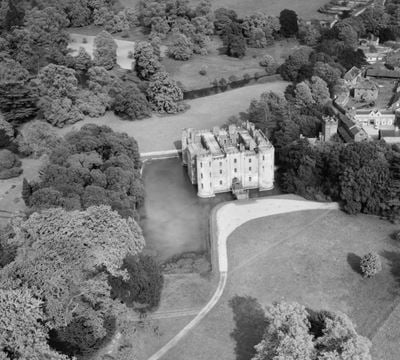
Shirburn
Shirburn Castle, Shirburn, 1953
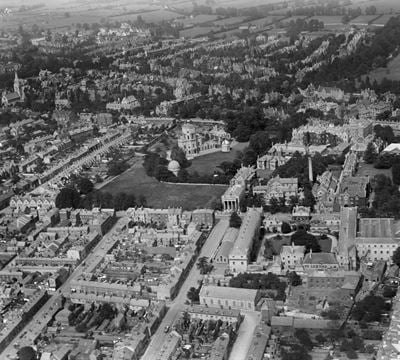
Oxford
The Radcliffe Observatory, Oxford, 1920

Oxford
The Radcliffe Observatory, Oxford, 1951

Broughton
Broughton Castle, Broughton, 1947

Broughton
Broughton Castle and St Mary's Church, Broughton, 1947
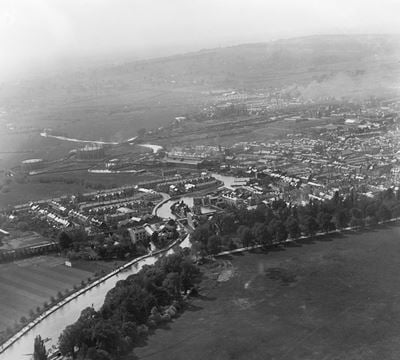
Oxford
Grandpont, Oxford, 1920

Oxford
The city, Oxford, 1947
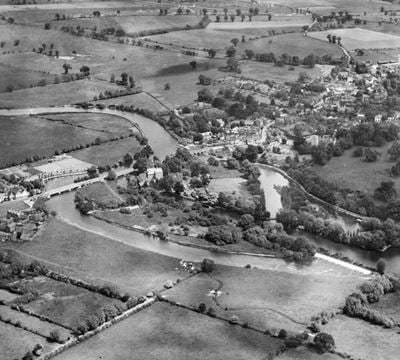
Sonning Eye
Sonning Bridge, the River Thames and Sonning, Sonning Eye, 1930
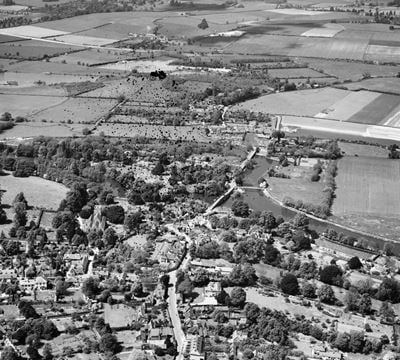
Sonning Eye
Sonning Village, Sonning Bridge and environs, Sonning Eye, 1948
Oxfordshire in the Historic England Archive
The Historic England Archive cares for over 15 million images, dating from the 1850s to the present day. Discover stunning images of Oxfordshire's past. Skip this section and go to stories about heritage
Eric de Mare
South Oxfordshire, Oxfordshire
Date created: 1945 - 1980
Exterior detail view of St Peter's Church in Wallingford.
John Gay Collection: Modern Architects
Vale Of White Horse, Oxfordshire
Date created: 1965 - 1970
A view from the garden showing the rear elevation of Kings Barn in East Hendred following its conversion to residential use
John Gay Collection: Rural Life
Oxford, Oxfordshire
Date created: Jul 1959
A tractor mounted aloft on the Massey-Ferguson stand at the Royal Show
John Gay Collection: Miscellaneous
South Oxfordshire, Oxfordshire
Date created: 1949 - 1951
A group of people arrive at Great Milton Neighbours Hall carrying blankets and lights for a music rehearsal
John Gay Collection: Counties
Lower Radley, Vale Of White Horse, Oxfordshire
Date created: 1959
Thatched cottages in Lower Radley, showing one with topiary in the garden
John Laing Collection
Vale Of White Horse, Oxfordshire
Date created: 21 Sep 1991
The entrance to Stirlings House retirement home
London, Midland and Scottish Railway Company
Christs Hospital, Vale Of White Horse, Oxfordshire
Date created: circa 1898
The interior of the oak cloister walk on the front of the Long Alley Almshouses
Alfred Newton and Sons
Culham, South Oxfordshire, Oxfordshire
Date created: Jun 1903
GENERAL VIEW FROM RIVERBANK
Nigel Temple Collection of Postcards of Parks and Gardens
Vale Of White Horse, Oxfordshire
Date created: 1900 - 1930
GENERAL VIEW SHOWING THE CASCADE WATERFALL
Margaret Tomlinson Collection
Oxford, Oxfordshire
Date created: Jan 1943 - Mar 1943
A view of Grandpont House from the River Thames
Walter Scott
West Oxfordshire, Oxfordshire
Date created: 1950 - 1970
St Mary's Church, viewed from the south-east
Eric de Mare
South Oxfordshire, Oxfordshire
Date created: 1945 - 1980
General view of Wallingford Bridge from the bank showing children in the water and on the bankside.
Stories about heritage in your local area
Historic England publishes news, blogs, research, videos, and podcasts celebrating England's rich heritage. Discover the stories we have about Oxfordshire. Skip this section and go to education
What Was the Capital of England Before London?
Mentions Christ Church, Bodleian Library and Schools Quadrangle Including the Divinity School and the Convocation House
London is England’s capital city now, but when was it founded? And what was the capital of England before London?
Groundbreaking English Women of Science
Mentions Inorganic Chemistry Laboratory (Old Chemistry Department), Somerville College, Walton House
Discover the lives of women who impacted scientific discoveries in England's history, such as Marie Stopes and codebreaker Joan Clarke.
Who Was the First King of England?
Mentions All Souls College, Front (Or South) Quadrangle, Including the Chapel and the South East Range on the High Street
Athelstan (or Æthelstan), the Anglo-Saxon ruler, is considered the first King of England, who reigned from AD 924 to 939.
The Life, Love and Legacy of Feminist Pioneer Rose Sidgwick
Mentions Somerville College, Library
Unpick the legacy of the historian who made pioneering contributions to history and international feminism.
What Is the Oldest House in England?
Mentions Frewin Hall
Discover when the oldest house in England was built. The earliest domestic house, Saltford Manor House, could date from the 12th century.
16 Historic Gardens and Landscapes to Visit
Mentions Oxford Botanic Garden
Try these English gardens if you’re looking for somewhere with spectacular garden scenery.
A Brief Introduction to Military Pillboxes
Mentions RAF Bicester: World War II airfield
Explore some of the anti-invasion defences built across England during the First and Second World Wars.
8 Sites of Scientific Discovery and Innovation
Mentions Somerville College, Hall and Maltland Block
From Charles Darwin to Alan Turing, discover incredible places in England connected to scientific achievement.
6 Historic Places That Inspired Tolkien’s Lord of the Rings
Mentions The White Horse hill figure 170m NNE of Uffington Castle on Whitehorse Hill
Catch a glimpse of Middle-Earth at these listed historical sites in England.
The History of Ukrainians in England
Mentions The New House with surrounding pool and garden wall to the west, The Japanese Garden at the New House
Ukrainians have influenced several sites across England. Here is a small selection.
5 Listed Pub Signs in England
Mentions The Spread Eagle Hotel
Take a look at these historic calling cards for pubs and inns across England.
A Brief Introduction to Christopher Wren
Mentions The Sheldonian Theatre
Christopher Wren was a polymath, scientist and world-renowned architect.
England's Suburbs 1820-2020
Mentions Oxfordshire
Historic England’s major national research project on the heritage of suburbs reaches its conclusion.
50 Years of Flying for Heritage
Mentions Oxfordshire
Learn about discoveries made in over 50 years of flying by Historic England aerial photographers and their predecessors.
Archaeological Sensitivity Mapping
Mentions Oxfordshire
Developing a methodology for understanding where future significant archaeological discoveries may be made.
The Roman Landscape Characterisation and Prediction Project
Mentions Oxfordshire
Harnessing the potential of existing knowledge to develop predictive models of Roman settlement.
Historic Watercourses and Climate Change: Mapping the History of Rivers and Floodplains
Mentions Oxfordshire
How a GIS tool can be used to gather information to manage historic watercourses and increase their resilience to climate change.
Historic Character and Good Design
Mentions Oxfordshire
Article exploring how historic character is a positive force in building distinctive, better designed, places.
Archaeology From a Distance
Mentions Oxfordshire
Aerial archaeology as social distancing: find out how the Historic England aerial survey team has adapted to restrictions during the Covid-19 pandemic
Heritage at Risk in the South East Revealed
Mentions Wallingford Castle, Oxfordshire
25 sites have been saved and 15 sites added to the Heritage at Risk Register 2023 in the South East of England.
Research Reports Roundup May 2023
Mentions Oxfordshire
An overview of additions to our Research Reports Database in February to May 2023.
Cambridge University’s Darwin College Protected
Mentions St Annes College, Wolfson and Rayne Buildings
The Dining Hall and the Rayne Building at Darwin College, Cambridge have been listed at Grade II.
Historic England Refreshes Energy Saving Guidance for Older Buildings
Mentions Oxfordshire
Historic England has refreshed energy saving guidance having surveyed the needs of people living in older buildings.
11 Remarkable Historic Pubs Given Protection
Mentions The North Star Inn public house, Oxfordshire
A project to save rare historic pub interiors sees 11 remarkable pubs being newly listed, having their listing upgraded or list entry updated.
Oxfordshire's social history through photos
Over 10,000 images from the Historic England Archive have been specially selected and re-captioned for teachers, students, and anyone who wants to learn more about their local area. Skip this section and go to grant-aided places
Yale and Harvard University members
Period: Victorian (1837 - 1901)
A group portrait of Yale and Harvard University men, possibly althletes, visiting Britain.
Yale and Harvard University members
Working Mens Club, Childrey, Oxfordshire
Period: Edwardian (1902 - 1913)
Several local gentlemen standing outside the Victorian building with a cupola and shaped gable motif, which also housed a reading room.
Working Mens Club, Childrey, Oxfordshire
Witney Mill, Witney, Oxfordshire
Period: Georgian (1714 - 1836)
This mill dates to c1820. The mill was water powered. It combined the fulling, weaving and spinning processes under one roof.
Witney Mill, Witney, Oxfordshire
William Smith Memorial, Churchill, Oxfordshire
Period: Victorian (1837 - 1901)
This monument has the inscription "In memory of William Smith, the Father of British Geology. Born at Churchill March 23, 1769.
William Smith Memorial, Churchill, Oxfordshire
White Horse Hill, Oxfordshire
Period: Victorian (1837 - 1901)
Bank Holiday picnickers on White Horse Hill gathered around a stall selling chocolate and bottled drinks.
White Hart Inn, Fyfield, Oxfordshire
Period: Medieval (Middle Ages) (1066 - 1484)
This pub was originally built as almshouses for the poor.
White Hart Inn, Fyfield, Oxfordshire
Wheatley Windmill, Wheatley, Oxfordshire
Period: Georgian (1714 - 1836)
This windmill was built in the mid 18th century. Records show that it was rebuilt in 1763 after a fire.
Wheatley Windmill, Wheatley, Oxfordshire
Wheatley Anglo-Saxon Cemetery, Wheatley, Oxfordshire
Period: Anglo Saxon (Britons/English/Vikings) (410 - 1065)
Looking into a trench at an exposed skeleton (identified as 'no.3') during archaeological excavations at an Anglo-Saxon cemetery site near the village...
Wheatley Anglo-Saxon Cemetery, Wheatley, Oxfordshire
Visit grant-aided places near you
These places and buildings have been helped by Historic England's financial grants. Find historic places in your neighbourhood that you never knew existed! Please note that opening times may vary. Skip this section and go to related locations
Swingbridge, Oxford
A swing bridge located to the north of Oxford Station.
Discover more
Ready for more local heritage? Take a look at these other places nearby


